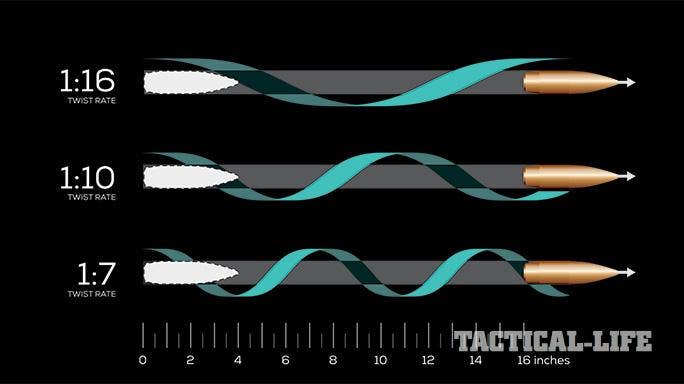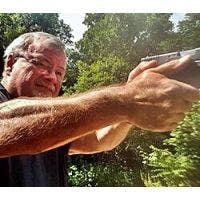C’mon, baby, let’s do the Twist! Ah, the good old days…
But what about barrel rifling twist? Well, if you don’t know much about a particular barrel’s twist, you could inadvertently end up buying a rifle that isn’t as accurate as you’d hoped it would be with your chosen ammunition. It helps if you understand the concept that some barrels will perform better with some bullet weights than others, depending on the rifling twist.
So, what is barrel rifling twist? I’ll use the AR platform in this discussion, but barrel twist rate applies to every gun – long guns and handguns – that have rifled barrels. Let’s explore the topic in a bit of detail.

How Rifling Works
It all starts with rifling. A rifle’s barrel is cut (by one means or another – that’s a separate topic covered in our blog about types of rifling) into lands and grooves. The land is the part of the barrel that is not cut, while the groove is the “trough” cut into the barrel. The cuts go in a spiral around the inside of the barrel. The bullet, when fired, is caught by the grooves and spun. The rate of twist in the rifling determines how fast the bullet is rotated one revolution.

Here’s an interesting photo from Guns America that shows AR rifling in all its glory:

So we see that the lands and grooves spiral around in a circle. Here’s a forehead-slapper statement…a rifle is a rifle because it has a rifled barrel. Shotguns are named properly. They are technically just guns because their barrels are not rifled (except for dedicated deer slug guns). It’s how soon they spiral around that defines twist.
A fast twist would have the grooves spiraling around 360 degrees in as few as 7 inches, while slower twist rates may turn that 7 inches into 12 or 14. We’ll look at what that means from a practical aspect in a bit.
But first, here’s another view from the muzzle…

Twist is loosely defined as the rate of spin in a rifled barrel and is represented as inches per turn. For example, a 1:7 twist would spin a bullet one revolution in 7 inches. I found a neat little illustration on Ballistic Magazine’s website that shows three different twists in a graphical representation…

What does this mean to the average rifle shooter? There are a few things to consider in order to ring out the most accuracy from your rifle you can.
Here’s a rule of thumb about twist rates and bullet weights. Small numbers equal faster twist:
The 1:(smaller number) twist will stabilize longer, heavier bullets
The 1:(larger number) twist will stabilize shorter, lighter bullets
Examples, AR rifles: 1:7, 1:14
For example, let’s consider a real-life example of twist rate and bullet weight/length. We’ll use the ubiquitous AR-15 (or rather the military equivalent, the M16/A4) as an example.
When the military first adopted the M16 rifle, they had 1:12 or 1:14 twist rates. That was good enough to stabilize the 55-grain bullet that most of those rifles shot. As situations developed, it was determined that longer, heavier bullets would be more effective, especially at longer ranges. The problem was that the high-numbered twist rate was designed for use with the original 55-grainers and wouldn’t shoot the longer bullets worth a darn.
So, in the 1980s, the military (and many other NATO countries) adopted 1:7 twist-rate barrels. This meant they could shoot the longer, heavier 70-plus grain bullets (plus the lighter 55-grain bullets) accurately.
Some countries and commercial manufacturers settled on a 1-in-9 twist, which did fine with 55- and 62-grain bullets but not so good with the longer 70-77 grainers. Accuracy was not the best. I’ve read about police agencies who received mil-surp M16s and A4s with either 1:9 or 1:7 twist rates. They had so-so results when shooting the Hornady 75-grain TAP T-2 and the 77-grain Black Hills Mk.
262 in the 1:9 twist barrels but had good results with the 7s. It was recommended by procurement officials to only add the 1:7 twist rate barrel rifles and carbines to their inventory from then on, as the “7s” also stabilized the 55-grain bullets well. It was kind of a no-brainer to use rifles that shot the whole gamut of ammo accurately.
It’s also been recommended that a 1-in-8 twist barrel might be a good compromise in an AR, but I think if I were to buy another one, I’d go with the 1:7 twist.
How To Match Ammo To Twist Rate
Let’s get things going with matching ammo to twist with this chart for the .223/5.56mm.

Let’s try to follow my rule of thumb above… understand that innate accuracy will be better if you keep the “small-number-twists” for the longer and heavier bullets, and the “larger-number-twists” for the lighter, smaller ones. Of course, there are exceptions… as I mentioned above, 1:7 twist barrels do tend to shoot both the 50-to-70-plus grain bullets well.
Here’s another chart from Rifle Shooter Magazine that might make things clearer.

Sticking with our AR example, it shows the .224 bullet/1:7 twist good for bullets in the 68-80 grain range but practical experience at my backyard range with my own 1:7 Del-Ton AR shows that twist rate to be good with 55-grainers as well, as I alluded to above.
Make sure you read the fine print at the bottom. Bullet grain weights are approximate guidelines. Things can change in the real world, so take the info given here for what it is… a guideline. At least it’s a starting point.
Matching your ammo to the twist rate of your barrel makes sense. I could even see someone who has inherited a whole lot of a certain type of ammo going out and buying a rifle with a suitable twist rate. Sometimes the ammo is worth more than the gun. If your Great Uncle Herkimer was a shareholder in an ammo company and put you in his will for his storage container full of 55-grain FMJ .223 in 40 zillion 20-round boxes, you might want to go get yourself an AR with a higher-number twist rate. This is a silly example, I know, but it makes the point that you should pay attention to the rifle’s twist rate when buying both the rifle and ammo for it.
What about other calibers? An example might be the .308. Some shooters like a 1:10 twist rate and others a 1:11 or even 1:11.25, but the general opinion seems to be that a 1:12 twist rate is about right for most any bullet weight, up to around 200 grains. Again, that’s just an educated opinion but just as the 1:7 may be best for an all-around .223/5.56mm rifle, so the 1:12 may be best for the .308. Just remember that nothing about shooting is carved into rock (except safety rules!) and all is dependent on the gun. All guns are different, as we know.
OK – Now What?
Learning about rifle barrel twist rates isn’t high on the list of most shooters… unless they like one-hole groups at ridiculous ranges. Going the other way, ever seen a target with a perfect silhouette of a bullet cut through it? The bullet keyholed due to insufficient stabilization and went sideways through the target. Not a good thing. Granted, for many of us everyday shooters twist rates don’t rate up there with things like the price of ammo, but it’s important to at least be aware of the barrel that is installed on your rifle and how the rifling will affect your groups with a given ammo.
Let’s face it… A happy rifle makes a happy shooter. Just pay attention to the twist rate of that new blaster you’ve plunked down your hard-earned money for and you’ll be doing the Twist after putting all your shots in one hole. Rifle barrel twist is something that you can choose – buy the right gun and ammo and be happy!
[Bear Creek Arsenal hands down manufacturers the best value AR-15 barrels, AR-10 barrels, and AR-9 barrels here in Sanford, NC as well as popular handgun barrels. Make sure to check them out and read other blog articles like cold hammer forging barrels and reflex vs. red dot sights!]











